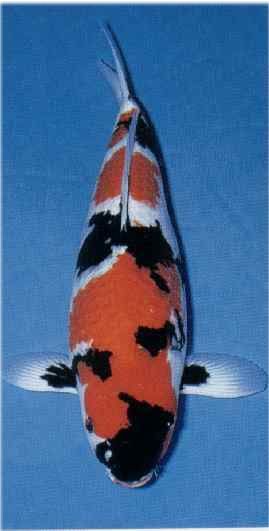
SHOWA KOI FISH -- Showa is also a Kohaku koi type, that has a black pattern on top. They are in gosanke koi classification. Select showa must start with that perfect Kokaku. The word, Kohaku, sure comes up a lot.Take the perfect Kohaku and add the black in the right places and you have Showa. Showa is koi type with combination of a good Kohaku and a good Shiro Utsuri koi type. Showa go through many changes as they grow. Many times the black is very deep and only comes out as the fish grows. For this reason, if you see gray areas, it might not be poor quality white but deep black that will appear later.
The sumi on the showa should be strong. It should look like it emanates from the bottom of the fish and properly wrap the body. It is this wrapping of color that gives the Showa the look of strength. There is no more powerful fish than a good Showa. It has double power in the wrapping of red and black. It also has the high contrast of three colors. After the head, the rest of the sumi should be bold and balanced. Look closely at body conformation because of all the black. The black can hide defects in body, mouth and head.
Showa Head
The head of showa should have all 3 colors (red, black and white), preferably in equal mounts. The head on a Showa is very important. This time the head must have black on it. In fact it must have all three colors on it. The shoulder area of the showa should have all three colors and the Ozuke, tail region, should also have all three Best would be to have a good kohaku head with either a lightening stripe or a v-shape in black on the top of the head. Many showas don't develop this until later, so just try to pick one that has good red and white with some black coming out. Classic head patterns start with a good Kohaku face. Then black comes either down the face to divide it, or down the face and across the shoulder to form a Y.This is called Hachiware
Showa Body
Good Kohaku pattern in the body is good showa ,it should be balanced and be placed all through the body. if black is either present or coming up all over the body. Don't worry if the black is of poor quality at an early age. Black develops later in most good quality showa. It is also okay to have an orange-red at this point because the red gets better as the fish grows. Good showa body conformation is like kohaku koi type.
Pectoral Fins
Ideally Showa Koi , almost all of the pectoral fins, except for the outermost tips, should be black. As the pectoral fins grow out, the black seems to stay the same and the white area on the outside seems to spread out. If the pectoral fins are all black at this time, it is often alright, as this too can grow out to have good showa fins.
Fins that are not acceptable are fins with any red, all white fins, or fins with very little black at the base. All other fins should preferably be white, but some black is acceptable. Red is not acceptable in the fins. Pectoral fins should have Sumi at the base, up against the body. This is called Motoguru.
Ideally it should come out about one third of the pectoral length. Also the most perfect motoguru is surrounded by white. The front ray of the pectoral is white. The sumi does not go to the tip and the back ray is white. Strong motoguru is an indication that the sumi will be stable as the showa Koi grows. Dorsal fin is best in white as is the tail, but black in them can be fine. Avoid brush sumi pectorals, which looks more like stripes, or solid black pectorals. Even on young koi, the pectorals should start having the sumi pull back.
Some modern Showa have clear fins, as Kohakus are bred back in the crosses to righten the red. See you must get back to that perfect Kohaku always. Nose sumi also adds to the elegance of Showa and makes it more powerful.
Percentage of 3 Color
Showa koi have 3 color ,another thing to look for in this particular fish is the percentage of the 3 colors to the total fish. The classic showas koi type used to be about 40% black, 40% red, and 20% white. The modern showas koi type , that many judges like, have equal amounts of all 3 colors.
As you can see, the showa are one of the most difficult koi to select at a young age because they change so much as they grow. It is this complexity that makes this one of my favorites of the varieties of koi.
Reference:
AKca Library




0 comments:
Post a Comment